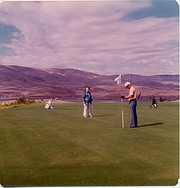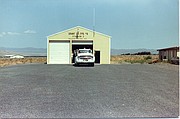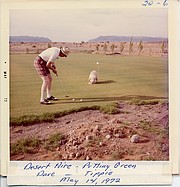A look at the history of Desert Aire
DESERT AIRE — “They expect it to be, they say, ‘the Palm Springs of the North,’ and they call it now ‘Desert Aire,’” read the newspaper from July 10, 1970.
In the spring of 1969, 3,200 acres of desert around the Priest Rapids area on the east side of the Columbia River was offered for sale. The site had formerly been part of the Figure 2 Ranch, a large cattle ranch whose main headquarters was covered up by the waters behind Priest Rapids Dam.
Harry Davidson, a recreation lands dealer from Seattle, and Ross Davidson viewed the property and saw the possibilities it offered. It was right next to the river. There was plenty of land for a golf course, an airport and other recreational facilities and things a small town might need.
The piece of land was up for sale by Marge McCormick, a Yakima real estate agent, for several owners scattered between Yakima and Sandpoint, Idaho.
“Earnest money was given to Mr. McCormick for the purchase price of $1,000,000 on terms,” wrote Ross Davidson in the book, ‘Desert Aire History,’ by Bob Kibler in 2006. “We soon formed a limited partnership and sold units to cover the down payment and development capital.”
The Planned Unit Development plan was submitted and approved by the county in 1970.
“The recreational aspects and the possibilities for future development of vast, previously virgin areas into agricultural uses was included in the master plan,” Davidson wrote.
Work began on the roads to the first 496 plots and the basic layout of the first nine holes of the golf course. Lots were ready for sale in May 1970.
Special invitations were sent out for a pre-public offering of the lots, including to the Vice President of the United States. Due to his busy schedule, he was not able to attend. In a letter from his assistant, he thanked Harry for the invitation and consideration.
Newspaper ads trumpeted the sale of the new lots.
“A land of contrasts with three miles of shoreline on an 8,000-acre lake,” read one ad. “A deluxe desert community rivaling Arizona and Southern California with a better year-round climate. It’s all under construction, now, today, right here in Washington. The finest investment period you will enjoy is now.”
Part of the promise of Desert Aire was the golf course.
“Desert Aire Golf Course has been a developing project from its beginning in ’70,” wrote Brian Mullen in “Desert Aire History.” “Harry Davidson’s crew, while laying out Desert Aire, developed the original nine holes. The original nine takes advantage of the great topography of the area. The course was built on the site without making changes in the lay of the land.”
The original promise for the golf course was 18 holes. It wasn’t until 1992 that the other nine were completed.
In the first few years of Desert Aire, a park was created. The first building in the park was the picnic gazebo. Near it, smaller picnic structures made out of metal boats were added. There was also a fishing pond. Other early buildings included a sales office, a pro shop and a chapel.
The first boat ramp, which consisted of concrete planks, had a habit of shifting during wind storms. In February of 1972 it was replaced with a solid ramp.
As time progressed, a gas station, restaurant, pool and other amenities were added.
The first fire response team was started in 1974. Six residents were trained to be the Quick Response Pickup.
In 1980, a fire station was built by Grant County Fire District 8. Land was donated by the Desert Aire Owners Association with the stipulation that the station was to be built by Aug. 1, 1980. The original building cost almost $12,000 and was 32 feet by 48 feet. In 1992, it was expanded to 62 feet by 32 feet.
The airstrip was originally installed in 1975. Harry Davidson used it to fly in potential buyers from Seattle.
“Years later, a deteriorated runway was fixed with a creative solution,” wrote Bob Kibler in “Desert Aire History.” “Grant County Airport District 1 … was formed by local ballot in February of 1994. The airport’s 50 acres was then leased by the Desert Aire Owners Association to the Airport District on a 20-year lease in August of that year, in return for capital improvements. It became a public-use airport, eligible for public dollars for improvement and maintenance. New paving and a lighting system was installed.”
In 1978, a senior citizen club was formed by members of the Presbyterian church.
“Dr. Oscar C. Perdomo and Bette Phillips saw the need for a ministry to retired person living in Desert Aire and adjacent communities,” wrote Oscar Perdomo in “Desert Aire History.” “He and Bette began to plan and search for ways to serve.”
The two began planning activities, such as a wellness clinic, for the areas seniors. At first, the group met in the church. Eventually became large enough where they had to move meetings to the Desert Aire Day Lodge Clubhouse.
“By 1981, the membership had grown considerably and the founders … decided to complete the paperwork to charter and incorporate the Sagebrush Senior Citizens Club in the State of Washington,” Perdomo wrote.
A dedicated senior center building was built in 1985. That same year, a senior band was formed.
The Citizens Patrol was also formed in 1985. It was instituted after a talk by Grant County Sheriff Weisner. In 1996, the Cop Shop was built. At the time it was built, the Grant County Sheriff’s office was awaiting grant monies to pay for a south county officer.
Rachal Pinkerton may be reached via email at rpinkerton@suntribunenews.com.









